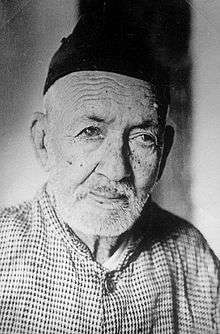Baburam Acharya
Baburam Acharya (Nepali: बाबुराम आचार्य) (1888–1971) was a Nepalese historian and literary scholar who coined the name Sagarmatha (सगरमाथा), for the mountain better known as Mount Everest or Chomolungma (in Sherpa language; Quomolungma in Tibetan).[1]
Itihas Shiromani Baburam Acharya | |
|---|---|
 Baburam Acharya at his old age | |
| Native name | बाबुराम आचार्य |
| Born | 1888 |
| Died | 1971 |
| Nationality | Nepalese |
His main work was the study of ancient Nepalese inscriptions.[2] Baburam Acharya is known as the "ITIHAS SIROMANI" of Nepal.Template:Main historian
Sagarmatha
Nepal’s eminent historian late Baburam Acharya is credited with the Nepali name Sagarmatha for Mount Everest that straddles Nepal-China border. Nepal had no official name of its own for the world’s tallest peak in Nepali (although official name among many Nepalese peoples - Sherpa, Limbu, etc., existed long ago) until the historian found out one. What may not be true however is that he coined the name for the mountain (as is put in the Wikipedia under his name). Baburam wrote an essay in the late 1930s in which he said that among the local populace of the remote Everest region the mountain was popular by the name Sagarmatha (meaning the Head of the Earth touching the Heaven); some even called it Jhomolongma. In his own words:
In the map of Nepal published by the then Survey of India Office, the name of the tallest peak of the Himalayan Mountain range was written as Mount Everest. In the map's second edition, the peak had two names: Mount Everest and the Tibetan name Chomolongma; but there was no Nepalese name. With a view to providing a Nepalese name, especially for the map, an investigative essay entitled as Sagarmatha or Jhomolongma was published in the Sharada, a Nepalese-language monthly.
The then rulers of Nepal took exception of publication of the essay and its publication, and the historian was admonished. In his book A Brief Account of Nepal, Baburam wrote
I was charged with attempting to bring about insult to the British by giving a Nepalese name to the peak already named after 'our friends,' and nearly deported from the country for publishing the article...
In his another book China, Tibet and Nepal Baburam wrote: "The name Sagarmatha already existed; I only discovered it; it is not that I christened the mountain with a new name."
Two decades after the publication of the essay, the Nepalese government gave official recognition to the name.
References
- Datta, Amaresh. Encyclopaedia of Indian Literature. Vol. 1, A-Devo. New Delhi: Sahitya Akademi, 1987. OCLC 34346316 p.807.
- Regmi, D. R. Inscriptions of Ancient Nepal. New Delhi: Abhinav Publications, 1983. ISBN 978-0-391-02559-2